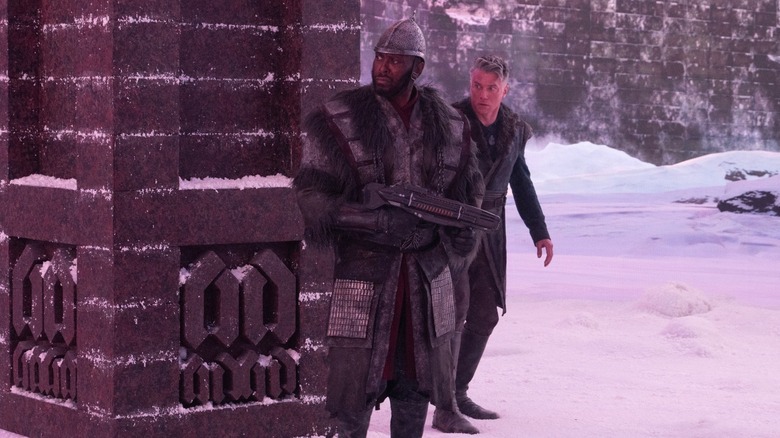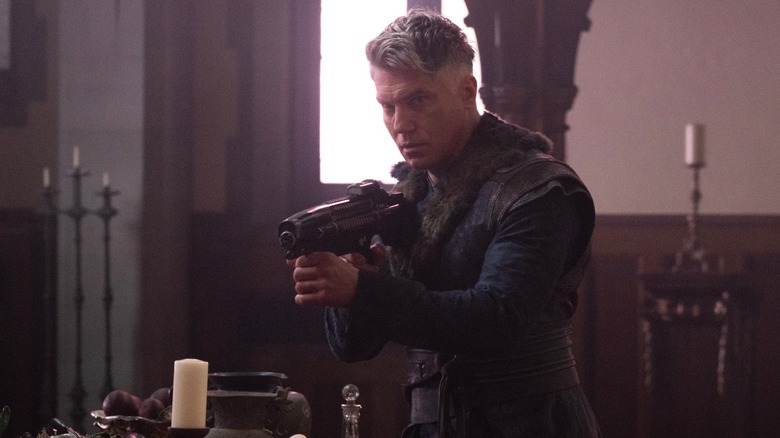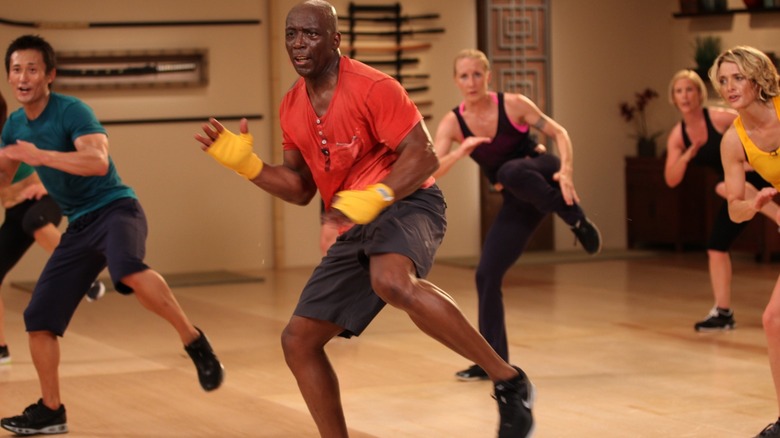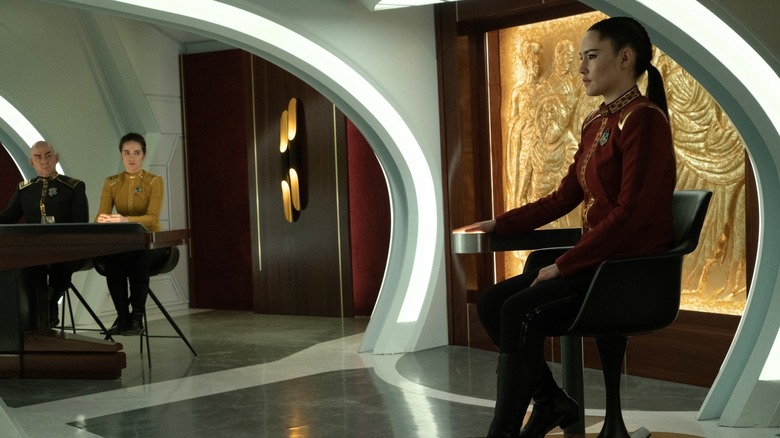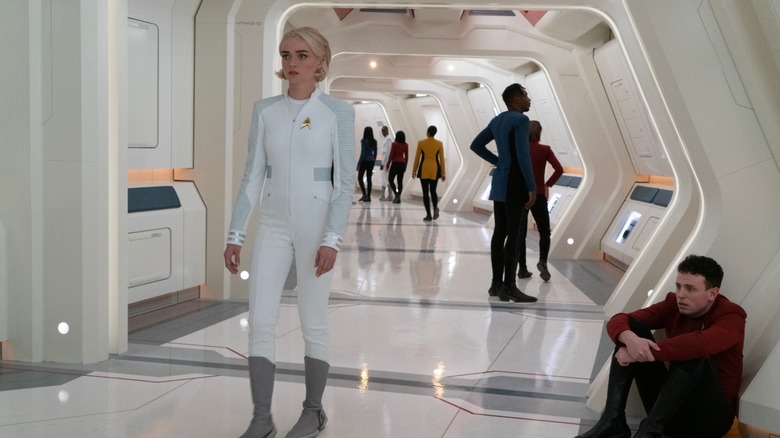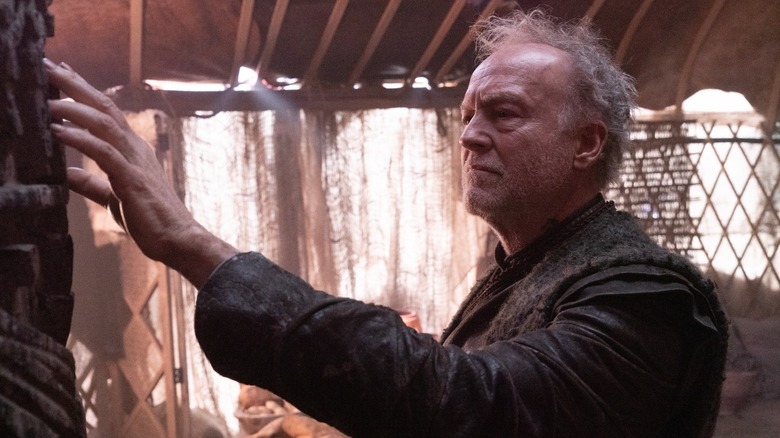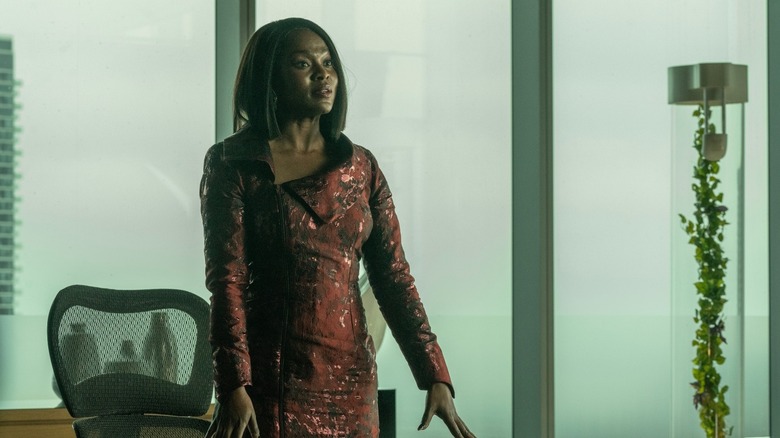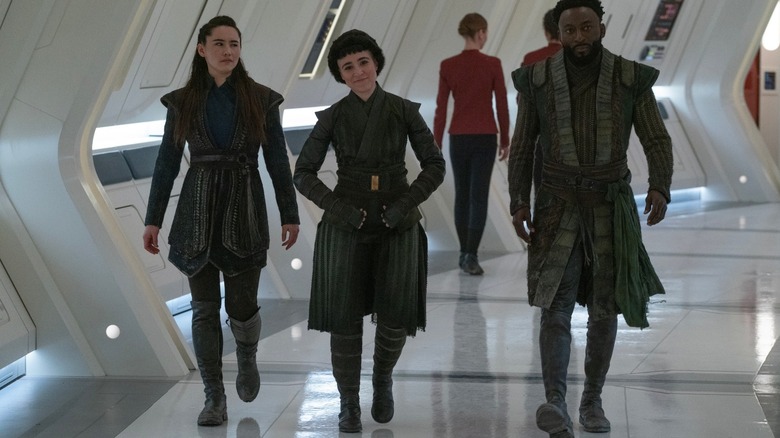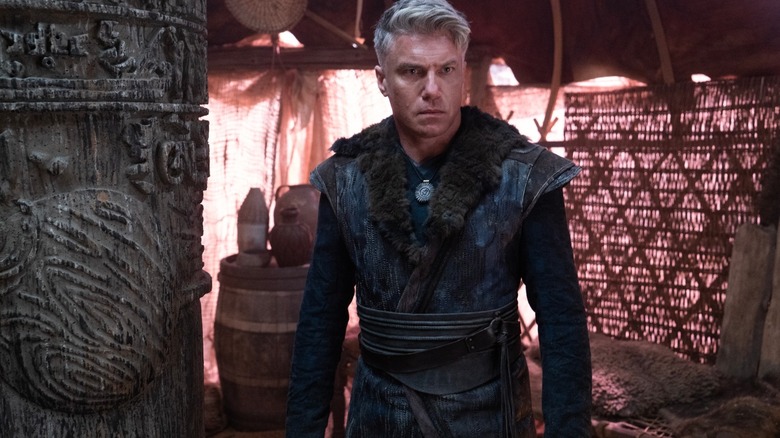Star Trek: Strange New Worlds Cinematographer On The AR Wall And Honoring Canon [Exclusive Interview]
Cinematographer Benji Bakshi has shot three films – "Bone Tomahawk," "Dragged Across Concrete," and "Brawl in Cell Block 99" – for director S. Craig Zahler. He has shot episodes of "Prodigal Son," "The Rookie," and the 2016 series "The Crossroads of History." Most recently, Bakshi served as cinematographer on two recent episodes of "Star Trek: Strange New Worlds," namely "Ad Astra Per Aspera" and "Among the Lotus Eaters." He also gained a lot of experience in the early 2010s shooting numerous workout videos for Billy Blanks. Lest one thinks it a churlish job, know that those things don't shoot themselves, and geniuses all gain experience somewhere.
"Strange New Worlds" is notable because it is one of the most recent shows to make use of an Augmented Reality wall, or AR wall. An AR wall is essentially an enormous, curved screen covered without thousands of LED lights that broadcast a background behind the actors in real-time. The background is a 3D composite that, thanks to high-tech motion-tracking software, shifts in accordance with the movements of the camera. An AR wall is far quicker and more practical than shooting a green screen and compositing a digital background in post-production, and Bakshi used the AR wall in both of his "Star Trek" episodes.
Bakshi recently say down with /Film to talk about his career, the pressures and freedoms of working on a legacy show like "Star Trek," the recent trends of making TV shows darker and darker, and the many advantages of shooting with an AR wall.
Note: This interview has been lightly edited for clarity and brevity.
'Having been in the music scene, I was always constructing narratives in my head about the music I was playing'
Looking over your filmography on IMDb leads to this question: What's the philosophy of lighting and shooting something like a Billy Blanks workout video versus a feature film or a TV show?
I don't think I've ever been asked that! Let me give you a concise but comprehensive background to sort of who I am and how I even got onto this path, because I started my creative career as a classical cellist and I'm a third-generation musician. My wife is also a musician; that's how we met. But we both actually grew into visual arts as we went. So having been in the music scene, I was always constructing narratives in my head about the music I was playing, and realized that I was actually a very visual person. But I hadn't pursued that. So I started making short movies in my backyard with a camcorder and thought, "Wow, this is really a craft that I think I can get into."
When I studied it in film school, I was given a Bolex 16mm film camera and a light meter, and they said, "Here, go expose some film and make this happen." I thought, hey, here's my instrument. I got to learn the technicals, and somehow practice this technical craft to the point where I can get an emotional response out of my viewers or listeners. So it was a very direct crossover to me. From there, I was making short films and things like that.
I also studied at AFI, the American Film Institute, and went there to learn how to really make Hollywood movies, higher quality. And ironically, I thought it was going to be purely focused on the technical — which it was, very much — but they really grilled you and enforced a dogma of being story-driven first. So from there, I graduated, and I won an award for a thesis film that I made. And I was looking for features and movies, and I had an opportunity to go shoot behind the scenes of these ... call them "big-budget fitness videos."
'We were up there with two cranes simultaneously and Steadicam on the top of a roof in L.A. shooting Billy Blanks with 300 people exercising on a big stage'
I thought, well, I need work. And the person who was running these at the time, his name was Darren Capik, and he was represented by CAA. There was a big industry; this was called the home video industry, and there was a whole arm of Hollywood that was still dedicated to this. So they were working with celebrities doing these things, and I started off supporting them as a gig and we grew in our relationship. He offered me the chance to shoot these bigger-budget things.
This is a really interesting conversation. I'm really glad that you brought it up, because I was able to shoot what, at the time, were kind of the biggest-scope productions I had access to. Rigging, studios, and sets, and working with cranes and bigger crews. And we had four cameras and all this kind of stuff. I was able to bring in a lot of my colleagues from AFI to operate the cameras, and it was a great time for all of us.
I also had the chance to hire some crew, like gaffers who I otherwise didn't have access to because the rates were good. So I worked with people who had done bigger TV shows and I'll name them: There's a gaffer named Dave Kagen who worked on "Mad Men" and other shows like this. And I worked with a gaffer named Erik Messerschmidt, who has since gone on to shoot "Mindhunter" as a DP, and got in a good rhythm with Dave Fincher ... and shot "Mank," for which he won the Oscar.
So I was able to open up and have access to this tier of Hollywood collaborators that at the time I hadn't since been able to, because these were more professional jobs that not only supported them financially, but we needed a big enough crew that they could bring their whole regular crew on.
So it was a really great learning experience for me, and it was surprising to me that they ended up on my IMDb. I didn't put them up there. I think that the people who did the credits just threw them up. And after a year or so of shooting some of these, I was like, "Oh my gosh, I've got 10 of these things on my IMDb." And for a while, I thought "Okay, there's a stigma to this," because people cut their teeth in various capacities.
After a while, I thought, you know what? It's great it helped me pay off my AFI loans. And the difference is it was shooting live TV. It wasn't shooting what we call a single-camera movie or series, but like I said, it was a great exercise in scope and we were up there with two cranes simultaneously and Steadicam on the top of a roof in L.A. shooting Billy Blanks with 300 people exercising on a big stage and stuff. And it was really cool. I got a chance to have to troubleshoot a lot of production issues that I hadn't had access to before. So it was a positive time for me. And we did cool stuff [like] shoot a yoga series that involved Deepak Chopra out in Joshua Tree and stuff like that. And it showed me that ... my dad is Indian, from India; I have a mixed background and I have that body type, and I had never really gotten into yoga before. So after shooting all these yoga series, I got into yoga and I've carried it with me since.
'Narrative was always my goal'
If the film and TV gigs ever fall through, you can go back to yoga videos and mentor the next generation of Oscar winners.
Exercise while you shoot. Right.
How does one transition from workout videos to features?
I don't really identify that that was my career. I really kind of saw it as a side gig. So how do I give you an interesting answer? Because I don't want the readers to feel like I started out in workout videos and then transitioned from that. It was very much not that because ... okay, for example, my thesis film coming out of the American Film Institute was this shot on Kodak film with film cameras and lenses and won an ASC award. That happened before I did any of that workout stuff. And I had actually shot two feature films before I did some of that stuff. So how can I describe it so that it's fun and it's a cool answer, but not like I don't want to misrepresent that I did this one thing and then did a different thing?
What I can say is that if your question is how does one transition, I was always shooting a narrative and narrative was always my goal. But the acquired skills that I got from a period where I was sort of in this commercial fitness world and what it taught me, I was able to apply the scope of what those were and some of the learning lessons like lighting big sets and doing three lights where I wouldn't get myself in trouble.
'This is a contemporary show built on 57 years of canon, but it also has to preempt all of it'
With "Star Trek," you're joining a 57-year-old franchise with a history of specific lighting and photography. Were there aesthetic mandates going in? Did you have to study older episodes?
The legacy is the facilitator — and the challenge — of this franchise. It's being written as we create and that becomes canon from which we have to integrate. So when I first started talking to the creatives at the show — that was Akiva Goldsman and Henry Alonzo Myers, the showrunners, and also the producing director, Chris Fisher. And I started "Strange New Worlds" in season 2. So I also met with Glenn Keenan, who was a cinematographer for the pilot and much of the first season of the show. There was discussion about, "Are you a Trekkie? Do you know about this show? And how do you think?"
They expressed that it was certainly not a requirement that I have any "Trek" background, but it's really more about who I was and how I think. Because any show that you start, you're going to have to grow into and do your own research to succeed. That said, I had grown up watching "Next Generation" reruns and things like that. And as I got older, I branched out into some of the older shows, namely the original series, because when I was younger, it was harder to digest. Seeing the anachronistic kind of styles, it didn't translate for me. [I had] to see through that and kind of appreciate the charm I was getting into original shows, too. Also "Twilight Zone," and things like that. I realized that I had a really strong affinity for sci-fi in general. That said, I'm also an AI enthusiast and have always tried to adapt the newest technology in what I'm doing.
I was ... I don't want to say early, but I was not resistant to the digital transition from celluloid film, and thought that any medium that succeeds is fair game. So similarly, that's my mindset and that worked well with how the creators think. So, since I was like-minded, the challenge became when I started working on the show: How do we honor canon? The showrunners and the writers really do an excellent job of that. By the time we are reading scripts, they have threaded the needles very well. That said, as the creative team, our job is to honor and also take the canon even further by creating around it. So I'd say 30% of any discussion we have about what we're doing is about canon. Where did it come from? How are we reinventing it? How are we creating our new story around it? And also how does it dovetail into the original series for which we were the prequel? Right? So this is a contemporary show built on 57 years of canon, but it also has to preempt all of it. What we have is a crew that loves this show has worked on other "Star Trek" shows, and they know everything. And if they don't know everything, they know where to find it. On set, we're having the live discussions about what's correct and what's not.
'We are very concerned and put a lot of energy into the story holding up and standing the test of time'
What were some of those conversations like? Were there any things you learned about "Trek" canon, either story-wise or photographically, that you've learned since taking the job?
Specific instances? Gosh, there's so much. Little things, like in the doorways of the bridge in the original series, there was a lighting effect where they shot light through a sort of metal grate and it created a shadow pattern around the doorways. And I don't know if that was actually ... I guess it was intentional, because they were creating a sort of visual interest. But the way it was done was using sort of antiquated lighting techniques. And a lot of effort was spent recreating that exact shadow pattern on the wall through the grate.
But we didn't want it to just splash all over the actor's face because that kind of looks like an old way of lighting, very shadowy and kind of rough. So they blocked out the center of the doorway so it wouldn't hit the people. But it was hitting the doorways. And that was a canon lighting effect on the doorway because if you look at this bridge, it needs to transition into the original series bridge. There's things like that that they wanted to maintain in honor.
Older "Trek" shows were blasted with a lot of light, making for bright, even lighting. The newer "Trek" shows, though, all seem to be dark and shadowy. Can you speak to that trend toward darkness in sci-fi TV, or is that something a little too oblique?
No, absolutely. So, I was recently asked the question: What we are doing in "Strange New Worlds?" Are we conscious of it, of trying to make it stand the test of time, aesthetically? And my answer to that is "no." Because I don't think it will. Every decade aesthetics are changing, and that's why we feel things feel contemporary or not. And I'm not worried about someone saying, "That looks dated," because that's really a mark of the industry in general; the zeitgeist of the world in a way, creatively. But we are very concerned and put a lot of energy into the story holding up and standing the test of time. So when I've gone through a few decades of watching "Star Trek," they all do have a morphing aesthetic that's trying to mimic what audiences are engaged in at the time.
And I would say that the blasted-with-light aesthetic was a mark of just the low sensitivity of film of the day, and also the lenses that they used being, what we call slower — not being able to accept more light.
'We have white walls on all our sets!'
So the result is: You need quantity, and that limits your ability to shape the quality. And when "Next Generation" came along, the film — they still shot on film — but the film stocks were more sensitive, the lenses were able to be more sensitive to light. And all of a sudden, you have a softer aesthetic that's matching the capabilities of the time. Keep in mind, you also have cinematographers like myself who have learned certain skill sets working in the industry, and they're going to apply those to those shows. So they're going to be essentially benefiting from the look of the time.
The trend towards darkness, I think, is also similar, where you've got a newer generation of streaming shows — "Star Trek" streaming shows — that are influenced by the more dramatic, serialized, darker aesthetic that is reminiscent of a lot of other popular shows. And I think that's what the trend is. So to break that in "Strange New Worlds" was definitely a risk. We have white walls on all our sets! That's a very telltale sign of the tone we're trying to set. And what's nice is that "Strange New Worlds" goes back to the optimism of "Trek" where we've come away each week feeling I think a little better, and the design of the sets, the influence of the lighting, sets that tone where it can be fun. It can still be dramatic, too.
Tell me about working with the AR wall. Is it a boon or a hindrance?
In general, I think it's great. It's some of the most fun I've ever had shooting film or TV. I think that it's very gratifying to have an in-camera process that places you in a fantastical environment. In the past, we used green screen or blue screen, and that was, as a cinematographer, pretty frustrating. Because you're trying to envision something, and there are many people involved in the step-by-step process of envisioning, shooting essentially the characters on nothing. Maybe there are a few practical set pieces that they have to interact with, and then it sort of just goes away. And lo and behold, there's a finished product that you had very little input in.
So we have the same kind of input from everyone. That used to be a very drawn-out process, but now it's culminating in a pre-production process with visual effects, the art department, production design, the writers, the lighting designers, and cinematographers like me and the other cinematographers on the show.
'I was surprised at which sets actually utilized the AR wall that I didn't think would'
We all get to weigh in and have our voices heard together so that when we're shooting the virtual worlds, they're representative of everyone's combined problem-solving, aesthetic, and storytelling. And it becomes a great aggregate of that stuff instead of potential conflicts along the way because everything was so piecemeal.
So that's my story about how much better I think the AR wall is than the blue screen or green screen process.
One of the great things about shooting on the AR wall is you can utilize the illuminating power of the LED screens as lighting in itself! Not only does the world that you can see create lighting, you can add shapes — almost like you're in Photoshop or something — and create a circle or a light bar across the top of the wall. And we have an LED ceiling that helps us with reflections, and we can create shapes in the ceiling that do all this.
So you're basically utilizing the power of the LED diode not only for visuals, but for imposed lighting that's coming from an off-camera source. That makes it feel really natural and convinces you even further that the world you're in is real. [That] it's extremely cohesive and makes the effect of the wall very hard to distinguish, which is the exact goal. We want our audience not to care whether we use it or not. We just want them to be immersed in the story.
When you're on a planet, it's pretty obvious that you're utilizing something like this, but some of the best examples of us using the AR wall are interior sets. And when I first had access to some of the footage before I joined the show, I was surprised at which sets actually utilized the AR wall that I didn't think would.
'We really have a lot of freedom'
Can you give an example of a scene that utilized the AR wall well?
Episode 4 ["Among the Lotus Eaters"], on Rigel VII, they were all over the place ... if you look beyond the edges of the frame in any wider shot that shows the crane is in there and the boom mic and stuff like that, you'll see all these little loops and blips that are influencing the lighting. And a lot of that is not just to light the characters, it's to affect what we call "the blend line" between the physical set and the wall where you want the wall to seamlessly transition from a lighting visual standpoint so that the sensation is sort of ignored. You want it to be seamless.
When working on something like "Star Trek," which has a legacy behind it, it doesn't seem like that leaves a lot of room for photographic creativity. Is there any kind of creative boundary that you feel yourself pushing up against when you're shooting something like "Star Trek?"
I thought similar things when I was considering working on the show, and we had these direct conversations because I'm an artist and I like to just be able to follow my instinct. I serve the shows that I work with and I am always supporting the director and the script that have already championed the project. So there's no real ego at play when I want to be able to do my own work or create my own looks. But it's really a matter of ... I think that my primary skill is my instinct, and if that's stifled, it gets tricky to feel like I'm adding the most value.
So I totally hear where you're coming from. But I had these discussions with the creatives as I was going to join the show, and they assured me that the door was wide open to be able to input and interpret and do what I thought would be the best of visual decisions. If there was a problem with my instincts, that could be addressed. But there really never was, to my satisfaction.
I think if you really kind of compare some of the episodes one-to-one, you'll start to see a lot of variation in lighting the same sets, especially lighting new sets and new worlds. We get to really push it. I'm told that I should consider the ship as the "mood board," the "feeling" of the episode. One of the other amazing things that Jonathan Lee, the production designer, and Glen Keenan, the first-season cinematographer, did really successfully was they embedded a ton of LED lighting within the surfaces: walls, ceilings, and even floors of the sets. [So] we can utilize and light the characters and give the space a feeling.
In episode 6, in particular, the ship goes through a couple of different light levels, and within the same sets, you can see those transitions in different parts of the episode. So we really have a lot of freedom. And I enjoy that because each episode is really its own genre and there can be some consistency. The sick bay needs to feel like a hospital, this and that, but sometimes the colors are different and it's really a lot of fun because you are telling the story of the continuing crew, but each week, you really don't know what you're going to get.
"Star Trek: Strange New Worlds" season 2 is streaming on Paramount+.
